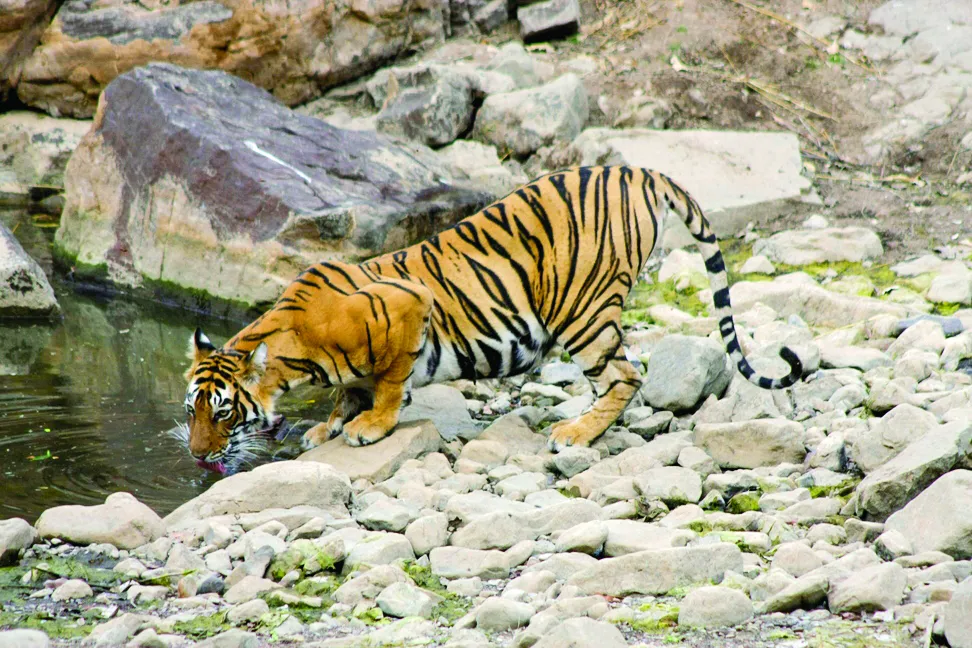We had spotted Shakti’s cub Durga, but our desire to see Sultana’s, Riddhi’s, and Arrowhead’s cubs was very much alive and we took the chance to visit zone four again. I was optimistic about seeing Riddhi and her cubs in particular, as we had heard about her movements there the previous evening. We set out for Malik Talao or Malik Lake, where, as soon as we reached, we could spot the footprints of tiger T-124, or Riddhi, as she is more popularly known. Zone four is very much her territory, as is zone three, and as the mother of three new cubs, we were hopeful we’d have a good sighting for a second safari in a row.
Soon after, we spotted a mongoose family which, according to local wisdom, is a lucky sighting. Although the former forest minister, renowned wildlife photographer and my good friend Bina Kak always used to joke that whenever she saw a mongoose, she could never get a glimpse of tigers.
The sighting of three spotted owlets was another bonus, after which we returned to the area around Malik Talao, where a crowd had gathered as they had heard a tiger roaring in the vicinity for quite some time. However, as so often happens, even after waiting there for a while, we were unsuccessful in spotting any movement of animals and so we moved towards the Wardha area of the forest. Here, too, there was no movement that we could see. With there being every possibility that the tigers might still be in the Malik Talao area, our forest guide Batti Lal Gurjar and our driver Goldy decided to head back.
When we reached Malik Talao, we happily watched as some crocodiles sunned themselves by the water. When the water bodies are full, you can see one or two of them by the banks, or half-submerged. But if you are there in the drier months, they are much easier to spot. They are not to be trifled with, known to prey upon even tiger cubs. Machli rose to fame partially because of her battle with one of them, and in a rare scene, recently Riddhi and her cubs also brought a crocodile down and were recorded making a meal of it. Close by Ranthambore National Park in Pali Ghat is the National Chambal Gharial Sanctuary where you can see the long-nosed endangered animals besides marsh crocodiles and some spectacular birds.
But it was precisely at this juncture that the SP’s driver, Arun, drove past at great speed, telling us to follow him as he continued to race ahead. There are few things as thrilling. We
followed him for about three minutes when we came to a screeching halt upon spotting the
tigress Riddhi with her three cubs.
Alongside us was another jeep bearing a young boy from Delhi, Agastya Bhartia, a regular at Ranthambore with his family. He was kind enough to make space for us so we could take
some better pictures as, by that time, the place had filled up with canters and other jeeps. I was sure that from the position Agastya was in, he must have got some good clicks of the
cubs before us.
Riddhi crossed the path right in front of us and was calling out to her cubs to follow, but being only about five months of age and still not so accustomed to the vehicles, they would
not follow their mother. Sensing their reluctance, Riddhi crossed our jeep, returned to her cubs, and sat down in the waters of the lake along with them. Mother in their midst, the little
ones continued to play in the shallow waters, and for all of us, it was a very satisfying and spellbinding sight to behold. We hardly realised the passing of long hours as the young ones
continued to amuse themselves.
As mentioned before, Riddhi is the reigning queen of Ranthambore. She is the great granddaughter of the famous tigress, Machli, now deceased, and the daughter of Arrowhead, who has recently had a new litter of her own. She has taken over the prime zone that once belonged to them. In 2022, she is believed to have had one cub who was later not seen, so
presumably did not survive. Even tiger cubs are vulnerable to predators. But the good news is that as of publishing, Riddhi’s 2023 litter of three was still thriving.
Forest official Shivraj, who was with Priyanka Vadra’s convoy the day before, joined us at
this juncture. After spending some more time by the lake, we headed back. But that wasn’t the end of our excitement that day, for as we were on the way out, we spotted some bears in
the Tambakhan or copper urn area of the forest.










